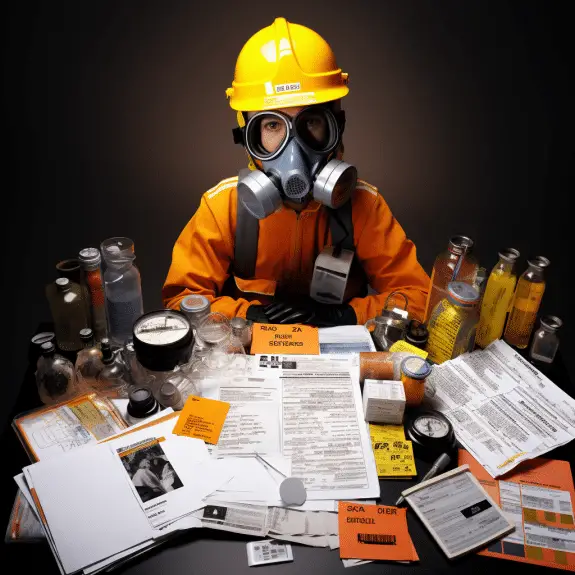Material Safety Data Sheets (MSDS)
Material Safety Data Sheets (MSDS) As a professional journalist, I am dedicated to providing accurate and comprehensive information on important topics. In this article, I will guide you through the essential aspects of understanding material toxicity, focusing on the significance of Material Safety Data Sheets (MSDSs) in ensuring workplace safety.
Material Safety Data Sheets (MSDSs) serve as invaluable tools for understanding the properties, hazards, and safe handling procedures of various materials. They contain vital information about product identification, composition, and first aid measures. The Canadian Centre for Occupational Health and Safety (CCOHS) plays a crucial role in promoting workplace safety by providing accurate and comprehensive MSDSs. Employers have the responsibility of ensuring that employees have easy access to MSDSs and understand the information provided.

Key Takeaways:
- Understanding material toxicity is vital for maintaining workplace safety and preventing hazards.
- Material Safety Data Sheets (MSDSs) provide comprehensive information on the properties and hazards of materials.
- MSDSs help individuals understand the proper handling procedures and emergency response for hazardous materials.
- Employers are responsible for ensuring the availability of MSDSs and employee comprehension of the provided information.
- Promoting workplace safety through material toxicity awareness should be a top priority for all individuals.
The Importance of Material Safety Data Sheets (MSDS)
Material Safety Data Sheets (MSDSs) play a crucial role in hazard communication and workplace safety. These documents provide detailed information about the hazards associated with specific materials, enabling employees to understand and mitigate risks effectively. By utilizing MSDSs, employers can ensure the safety and well-being of their workforce, minimize the potential for accidents or injuries, and comply with regulatory requirements.
Effective hazard communication is vital in the workplace to prevent incidents and protect employees. MSDSs provide essential information on the properties, composition, and potential health effects of materials, ensuring that employees are well-informed about the substances they work with. By understanding the hazards, workers can implement appropriate safety measures and response protocols, reducing the risk of exposure and harm.
Complying with MSDS guidelines is not only a legal requirement but also an ethical responsibility. Employers must ensure that MSDSs are readily available to employees and that they understand the information provided. This includes training employees on how to access and interpret MSDSs, and the importance of following the recommended safety measures. By prioritizing MSDS compliance, employers demonstrate their commitment to the well-being of their workforce and create a safer work environment.
Proper utilization of MSDSs is essential for workplace safety and hazard communication. By providing comprehensive information about material hazards, MSDSs enable employees to understand and mitigate risks effectively. Employers must prioritize MSDS compliance to protect their workforce and ensure regulatory compliance.
| Benefits of MSDS compliance: | Consequences of non-compliance: |
|---|---|
|
|
Understanding the Sections of a Material Safety Data Sheet (MSDS)
Material Safety Data Sheets (MSDSs) are an important resource for understanding the toxicity of materials and ensuring workplace safety. These sheets are divided into several sections, each providing specific information about the material in question. We can comprehend the material’s product identification, danger identification, composition, and first aid procedures by reading an MSDS.
Product Identification
The product identification section of an MSDS provides key information about the material, such as its name, manufacturer, and contact details. This section also includes details about any specific codes or identification numbers associated with the material. Having accurate product identification is essential for proper handling and communicating potential hazards.
Hazard Identification
The hazard identification section outlines the specific hazards associated with the material. This includes information on the potential health effects, such as skin or respiratory irritation, as well as any physical hazards like flammability or reactivity. Understanding these hazards can help individuals implement appropriate safety measures and prevent potential accidents or injuries.
Composition
The composition section of an MSDS provides information about the components or ingredients of the material. It includes details about the chemical substances present and their respective concentrations. This information is crucial for assessing any potential health risks associated with exposure to the material and understanding its overall composition.
First Aid Measures
The first aid measures section of an MSDS provides instructions on how to respond in case of exposure or accidents involving the material. It includes information on appropriate first aid procedures, such as eye irrigation, skin decontamination, or inhalation treatments. This section also outlines the symptoms of exposure and when to seek medical treatment. Familiarizing ourselves with the first aid measures for a specific material can help mitigate potential health risks and ensure prompt and appropriate responses in case of emergencies.
| MSDS Sections | Key Information |
|---|---|
| Product Identification | Material name, manufacturer, contact details |
| Hazard Identification | Potential health effects, physical hazards |
| Composition | Chemical components and concentrations |
| First Aid Measures | Instructions for responding to exposure or accidents |
Hazard Identification in Material Safety Data Sheets (MSDS)
One of the most crucial sections of a Material Safety Data Sheet (MSDS) is the hazard identification section. This section provides essential information about the potential health effects of a material and how exposure can occur. By understanding the hazards associated with a material, individuals can implement appropriate safety measures to protect themselves and others from harm.
The hazard identification section includes information on both acute and chronic health effects. It outlines the symptoms of overexposure and the routes of entry for the material, such as inhalation, ingestion, or skin contact. This information helps individuals recognize the signs of exposure and take necessary precautions to prevent further harm.
“The hazard identification section of an MSDS helps workers identify the potential risks associated with a material and take necessary precautions to protect their health and safety.”
In addition to identifying health effects, this section also provides information on whether the material is a skin or respiratory sensitizer, a carcinogen, or a reproductive toxicant. Understanding these specific hazards allows individuals to implement targeted safety measures and minimize the risks associated with the material.
Exposure Routes
The hazard identification section of an MSDS also highlights the various exposure routes for a material. It provides information on how the material can enter the body, such as through inhalation, ingestion, or skin absorption. By understanding the different exposure routes, individuals can take appropriate precautions to minimize their risk of exposure and reduce the potential for adverse health effects.
Overall, the hazard identification section of an MSDS plays a critical role in ensuring workplace safety. By providing comprehensive information about the potential health effects and exposure routes of a material, individuals can make informed decisions and protect themselves and others from the hazards associated with toxic substances.
Exposure Controls and Personal Protection in Material Safety Data Sheets (MSDS)
Follow exposure controls and use PPE to reduce hazardous substance exposure. Exposure controls limit hazardous material exposure. Engineering controls like ventilation systems and enclosures minimize material discharge and spread in the workplace.
PPE is crucial for worker safety, together with engineering controls. Gloves, goggles, respirators, and protective garments protect against dangerous materials. The type of PPE needed depends on the material’s dangers, so follow the manufacturer’s instructions and make sure it fits.
By implementing both exposure controls and personal protective equipment, workplaces can effectively reduce the risk of exposure to hazardous materials. This not only protects the health and safety of employees but also helps to ensure compliance with workplace safety regulations. It is important for employers to provide the necessary controls and equipment, as well as training on their proper use, to help create a safe working environment.
“Exposure controls and personal protective equipment play a vital role in minimizing the risks associated with hazardous materials. By following the recommended controls and utilizing the appropriate PPE, individuals can protect themselves from exposure and prevent potential health effects.” – Workplace Safety Expert
First Aid Measures in Material Safety Data Sheets (MSDS)
In the event of an emergency or toxic exposure, knowing the proper first aid measures can make a significant difference in minimizing the potential harm. Material Safety Data Sheets (MSDS) provide valuable instructions on how to respond effectively. Here are some important first aid measures outlined in MSDS:
1. Eye Irrigation:
If a hazardous material comes into contact with the eyes, immediate and thorough irrigation is crucial. Use clean water to rinse the eyes continuously for at least 15 minutes, ensuring that water flows away from the unaffected eye.
2. Skin Decontamination:
If the material makes contact with the skin, promptly remove all contaminated clothing and thoroughly wash the affected area with mild soap and water. If necessary, seek medical attention for further evaluation.
3. Inhalation Treatment:
If there is inhalation exposure to a toxic substance, it is essential to move the affected individual to an area with fresh air. Provide oxygen if available and seek medical attention promptly. Do not induce vomiting unless instructed by a healthcare professional.
“Following the recommended first aid measures can help mitigate the potential health risks and ensure prompt and appropriate responses in case of emergencies.” – Workplace Safety Advocate
It is important to note that the first aid measures provided in an MSDS are general guidelines and may vary depending on the specific material and situation. It is crucial to familiarize yourself with the MSDS of the material you are working with and follow the instructions provided. In case of any doubts or uncertainties, always seek professional medical assistance. Remember, immediate and appropriate first aid response can save lives and prevent further harm.
| Material | First Aid Measures |
|---|---|
| Chemical X | Rinse eyes with water for 15 minutes. Remove contaminated clothing and wash the affected area with mild soap and water. |
| Substance Y | Move to an area with fresh air. Provide oxygen if available. Seek medical attention. |
| Product Z | Flush eyes with water for at least 20 minutes. Remove contaminated clothing and thoroughly wash skin with mild soap and water. |
Storage and Handling Guidelines in Material Safety Data Sheets (MSDS)
Proper storage and handling of hazardous materials is essential for maintaining workplace safety. Material Safety Data Sheets (MSDSs) provide valuable guidelines and recommendations to ensure the safe storage and handling of these substances. By following these guidelines, employees can minimize the risk of accidents, spills, or other incidents that could lead to exposure or contamination.
The storage and handling section of an MSDS provides specific instructions and requirements for storing and handling the material. It includes information on storage conditions, such as temperature and humidity, as well as any incompatible materials that should be kept separate. Following these guidelines is crucial for preventing reactions or reactions that could result in hazardous situations.
In addition to storage considerations, the handling procedures detailed in the MSDS provide important information on safe practices for using and working with the material. This may include guidance on wearing personal protective equipment (PPE), using engineering controls such as ventilation systems, and implementing proper procedures for transferring or dispensing the substance.
Material Compatibility
Material compatibility is a critical aspect of storage and handling. It refers to the ability of different substances to be stored or used together without causing adverse reactions or hazards. The MSDS may provide information on the compatibility of the material in question with other common substances.
| Material | Compatibility |
|---|---|
| Acid | Incompatible with bases |
| Flammable liquid | Keep away from ignition sources |
| Oxidizer | Avoid contact with combustible materials |
Understanding the compatibility of a hazardous material is vital for preventing dangerous reactions or the creation of harmful byproducts. It is essential to review the MSDS and ensure that all storage and handling practices are compatible with the material to minimize the risk of accidents or incidents.
Physical and Chemical Properties of Materials
In order to understand the potential hazards and safe handling procedures of a material, it is important to analyze its physical and chemical properties. These properties provide valuable information about the characteristics of the material, enabling us to assess its potential risks and implement appropriate safety measures.
Physical Properties:
The physical properties of a material refer to its observable characteristics, such as color, odor, state (solid, liquid, or gas), and density. These properties can help us identify the material and assess its potential impact on the environment. For example, the color of a substance might indicate its level of purity, while the odor can provide clues about its toxicity or reactivity.
Chemical Properties:
The chemical properties of a material encompass its reactivity, stability, and compatibility with other substances. Understanding these properties is essential for handling the material safely and avoiding dangerous reactions. For instance, a highly reactive material may require special precautions to prevent explosions or fires, while a stable material may be easier to handle and store.
Toxicity Information:
Additionally, the physical and chemical properties section of a material safety data sheet (MSDS) often includes information about the material’s toxicity. This information helps us understand the potential health effects associated with exposure to the material. It may include details about acute or chronic toxicity, as well as any specific risks to certain organs or bodily systems. By being aware of the toxicity information, we can take necessary precautions to minimize exposure and protect ourselves from harm.
| Property | Description |
|---|---|
| Color | The color or appearance of the material. |
| Odor | The scent or smell associated with the material. |
| State | Whether the material is a solid, liquid, or gas at standard temperature and pressure. |
| Density | The mass of the material per unit volume. |
| Reactivity | The material’s tendency to undergo chemical reactions. |
| Stability | The ability of the material to maintain its chemical composition and properties over time. |
| Compatibility | The ability of the material to coexist or interact with other substances without undesirable effects. |
Toxicological Information in Material Safety Data Sheets (MSDS)
The toxicological information section of a Material Safety Data Sheet (MSDS) provides crucial details about the potential health effects of exposure to a material, helping individuals understand the specific risks associated with it and take necessary precautions to prevent adverse health effects. This section includes information on acute and chronic effects, exposure routes, carcinogens, and reproductive toxicants.
Health Effects
The toxicological information section outlines the potential health effects that may occur upon exposure to a particular material. It provides details on both acute and chronic effects, allowing individuals to understand the immediate and long-term impacts on their health. By being aware of these effects, workers can take appropriate measures to protect themselves and minimize the risks associated with the material.
Exposure Routes
Understanding the exposure routes is essential in determining how individuals may come into contact with a hazardous material. This section of the MSDS provides information on how the material can enter the body, such as through inhalation, ingestion, or skin contact. By knowing the possible routes of exposure, workers can implement appropriate safety measures to minimize the risk of exposure and prevent health complications.
Carcinogens and Reproductive Toxicants
The toxicological information section of an MSDS also highlights whether the material is classified as a carcinogen or reproductive toxicant. Carcinogens have the potential to cause cancer, while reproductive toxicants may have adverse effects on fertility or the development of an unborn child. This information is vital for individuals who may be at higher risk, such as pregnant workers, and helps employers implement additional safety measures to protect their employees.
| Section | Description |
|---|---|
| Health Effects | Outlines the potential health effects upon exposure |
| Exposure Routes | Details how the material can enter the body |
| Carcinogens and Reproductive Toxicants | Identifies if the material is a carcinogen or reproductive toxicant |
Environmental Impact and Disposal Considerations in Material Safety Data Sheets (MSDS)
When it comes to handling hazardous materials, understanding their environmental impact and proper disposal is crucial. The ecological information and disposal considerations section of a Material Safety Data Sheet (MSDS) provides valuable insights into these aspects. It offers essential details about the material’s potential impact on the environment and outlines the recommended methods for disposal.
By examining the ecological information in this section, we gain an understanding of how the material may affect the air, soil, or aquatic life. This information is crucial for making informed decisions about the use, storage, and handling of the material. It helps us identify any potential risks to the environment and take appropriate measures to minimize those impacts.
Additionally, the disposal considerations provided in this section guide us on the proper methods for disposing of the material. It highlights any special handling requirements or regulations that must be followed to ensure safe and responsible waste management. By adhering to these guidelines, we can minimize the material’s ecological footprint and contribute to environmental sustainability.
Key Points:
- The ecological information section of an MSDS provides insights into the material’s potential impact on the environment.
- Understanding the environmental impact helps in making informed decisions about handling and storage.
- Disposal considerations in the MSDS guide us on the proper methods for waste management and ensure compliance with regulations.
By paying attention to the environmental impact and disposal considerations outlined in MSDSs, we can play our part in protecting the environment and promoting sustainable practices.
| Ecological Information | Disposal Considerations |
|---|---|
| Information on the material’s toxicity to air, soil, and aquatic life | Guidelines for proper disposal methods |
| Indications of any potential risks to the environment | Special handling requirements for disposal |
| Insights into the material’s impact on ecosystems | Regulatory compliance for waste management |
Compliance with Regulatory Standards in Material Safety Data Sheets (MSDS)
OSHA sets workplace safety rules in the US, while WHMIS regulates in Canada. These requirements must be understood and followed to safeguard workers and prevent hazardous material mishaps.
MSDSs contain important regulatory information including exposure limits, labeling requirements, transportation laws, and more to ensure compliance. These requirements reduce hazardous material handling risks and ensure a safe and healthy workplace. Employers can meet legal requirements and show workplace safety by following MSDS rules.
Key Requirements
Compliance with regulations protects employees and helps companies avoid costly fines and legal issues. Maintaining compliance requires staying abreast of regulatory changes. Training and communication with employees can assist promote a safety culture in the workplace by emphasizing these norms.
Employers can control hazardous material risks, safeguard workers, and maintain a safe and healthy workplace by emphasizing regulatory compliance and using MSDSs.
| Regulatory Standards | Key Requirements |
|---|---|
| OSHA (United States) | – Setting and enforcing workplace safety standards – Providing training, outreach, education, and assistance – Requiring employers to maintain safe and healthy workplaces |
| WHMIS (Canada) | – Ensuring the provision of accurate and comprehensive MSDSs – Hazard classification and labeling of hazardous products – Employee education and training on hazard communication |

Conclusion
Understanding material toxicity and prioritizing workplace safety are essential for promoting a safe and healthy work environment. By familiarizing ourselves with Material Safety Data Sheets (MSDSs) and adhering to their guidelines, we can increase awareness of hazardous materials and minimize risks. Employers should ensure that MSDSs are readily available to employees and that they understand the information provided.
MSDSs play a critical role in hazard communication, providing detailed information on the potential health effects, exposure routes, and safe handling procedures for specific materials. By properly utilizing MSDSs, employers can protect their employees’ well-being, minimize accidents or injuries, and comply with regulatory requirements.
Each section of an MSDS, from hazard identification to storage guidelines, provides valuable information for workers. It is crucial to understand the material’s toxicity, physical and chemical properties, and toxicological information to implement appropriate safety measures. Additionally, the first aid measures and disposal considerations outlined in MSDSs help individuals respond effectively to emergencies and minimize the material’s ecological impact.
Workplace safety should always be a top priority, and understanding material toxicity is fundamental to achieving this goal. By prioritizing the knowledge and implementation of proper safety measures in accordance with MSDSs, we can create a safe working environment and promote awareness of the potential hazards associated with materials.
FAQ
What is an MSDS?
An MSDS, or Material Safety Data Sheet, is a document that provides information on the properties, hazards, and safe handling procedures of a material.
What information does an MSDS provide?
An MSDS provides information on product identification, hazards, composition, first aid measures, fire fighting measures, handling and storage, exposure controls, physical and chemical properties, toxicological information, ecological information, and more.
Who provides MSDSs?
The Canadian Centre for Occupational Health and Safety (CCOHS) is one organization that provides accurate and comprehensive MSDSs to promote workplace safety.
Who is responsible for ensuring MSDSs are available to employees?
Employers are responsible for ensuring that MSDSs are readily available to employees and that they understand the information provided.
Why are MSDSs important?
MSDSs are a crucial component of hazard communication in the workplace. They provide detailed information about the hazards associated with a material, allowing employees to understand and mitigate those risks.
What is the hazard identification section in an MSDS?
The hazard identification section outlines the potential health effects of a material and how exposure can occur. It includes information on acute and chronic health effects, symptoms of overexposure, and routes of entry such as inhalation, ingestion, and skin contact.
What is the exposure controls and personal protection section in an MSDS?
The exposure controls and personal protection section provides information on how to minimize exposure to a hazardous material. It outlines engineering controls, such as ventilation systems, and personal protective equipment (PPE), such as gloves, goggles, or respirators.
What is the first aid measures section in an MSDS?
The first aid measures section provides instructions on how to respond in case of exposure or accidents involving the material. It includes information on appropriate first aid procedures, symptoms of exposure, and when to seek medical treatment.
What is the handling and storage section in an MSDS?
The handling and storage section provides guidelines for safely storing and handling the material. It includes information on storage conditions, incompatible materials, and safe practices for handling the substance.
What is the physical and chemical properties section in an MSDS?
The physical and chemical properties section provides detailed information about the material’s characteristics, such as physical state, color, odor, boiling point, and flash point. It may also include information about the material’s toxicity, stability, and reactivity.
What is the toxicological information section in an MSDS?
The toxicological information section provides detailed information about the potential health effects of exposure to the material. It includes information on acute and chronic effects, routes of entry, and whether the material is a skin or respiratory sensitizer, a carcinogen, or reproductive toxicant.
What is the ecological information and disposal considerations section in an MSDS?
The ecological information and disposal considerations section provides information on the material’s potential impact on the environment and proper disposal methods. It includes information on the substance’s toxicity to aquatic life, soil, or air, as well as any special handling requirements for disposal.
What is the regulatory information section in an MSDS?
The regulatory information section provides information on the material’s compliance with regulatory standards, such as WHMIS in Canada or OSHA standards in the United States. It may include information on permissible exposure limits, labeling requirements, transportation regulations, and more.
Why is understanding material toxicity important?
Understanding material toxicity and implementing proper safety measures is crucial for protecting workers’ health and maintaining a safe working environment.
Source Links
https://www.ccohs.ca/products/supplements/msds_ftss/msds_understand.html
https://www.chemscape.com/resources/sds-fundamentals/sds-guide








